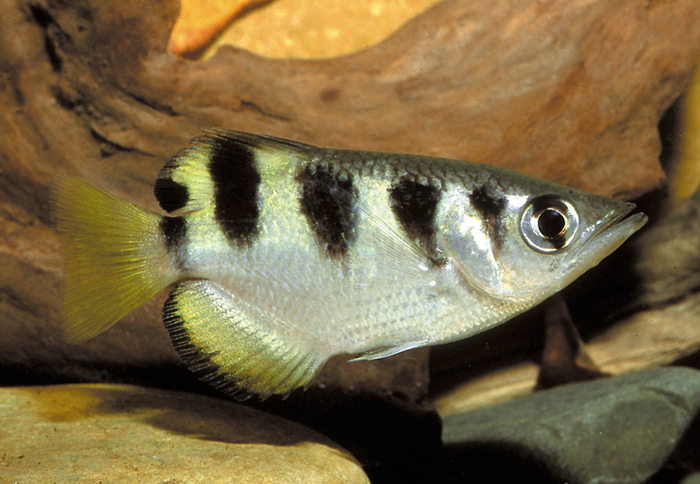- Classification
- ACTINOPTERYGII
- PERCIFORMES
- TOXOTIDAE
- Toxotes
- jaculatrix
Banded Archerfish, Toxotes jaculatrix (Pallas 1767)

A Banded Archerfish, Toxotes jaculatrix. Source: Gerald R. Allen / Western Australian Museum. License: All rights reserved
Great video of Archerfish in the wild shooting down insects.
Video of Banded Archerfish shooting insects off a branch.
Banded Archerfish, Toxotes jaculatrix (Pallas 1767)
More Info
|
Distribution |
Found in northern Australia from Yampi Sound, Western Australia, to Cairns, Queensland. Elsewhere, the species is widespread in the tropical east-Indo-west Pacific - from India to northern Australia, New Guinea, Solomon Islands, Vanuatu, Palau. Although Banded Archerfish are able to move between freshwater and inshore marine environments, they spend much of their time amongst mangroves. Juveniles aggregate in small numbers around half-submerged stumps or logs, and under overhanging branches. Adults are solitary or occur in groups of up to about 20, usually feeding at the surface. |
|
Features |
Dorsal fin IV-V, 11-13; Anal fin III, 15-17; Pelvic fin I, 5; Pectoral fin 12-13; Gill rakers (lower limb) 5-7; Lateral line scales 26-30; Transverse scales 3-4/1/8-9. Body oval to rhomboid, moderately compressed, depth 2.1-2.4 in standard length. Head pointed, length 2.3-2.7 in standard length. Snout 3.4-3.7 in head length. Eye large 3.2-3.6 in head length. Interorbital 2.8-3.8 in head length. Mouth moderately large, protractile, with lower jaw protruding; angle of jaw oblique, about 35°-40° to horizontal; maxilla slender, scaly and without a supplemental bone; villiform teeth on jaws, vomer, and palatines; a deep longitudinal groove on roof of mouth, which is converted to a tube when tongue is pressed against it. Caudal peduncle depth 2.5-3.4 in head length. Scales are moderately large, ctenoid, extending onto head and median fins; scale rows on body running horizontally; cheeks and operculum scaly; lateral line continuous, curving above pectoral fin.Dorsal fin continuous, positioned on posterior half of body, opposite anal fin; fourth, and occasionally third spine usually longest, 1.7-1.9 in head length. Caudal fin truncate. Pectoral fins pointed. |
|
Size |
To 30 cm TL, commonly to 20 cm. |
|
Colour |
Whitish to tan, sometimes with a silvery sheen, becoming brown on the back; series of 4-5 black bars, mostly on upper sides; dorsal, anal, and pelvic fins blackish; caudal fin pale to dusky; pectoral fins pale. |
|
Feeding |
Omnivore - feeds on floating matter at the surface, along with insects and spiders dislodged from vegetation above the water by jets of water. |
|
Biology |
Oviparous, pelagic spawner; producing numerous buoyant eggs. |
|
Fisheries |
Moderately important food fish in parts of Indonesia and Southeast Asia; taken by handline, block nets and gill nets, and marketed fresh. |
|
Etymology |
Toxotes is from Greek, and means 'archer' or 'bowman'. The species name jaculatrix means 'caster' or 'thrower' - both in reference to the archerfish ability to shoot water 'arrows' through the mouth. |
|
Species Citation |
Sciaena jaculatrix Pallas 1767, Philos. Trans. R. Soc. Lond. 56(1766): 187. Type locality: Jakarta (as Batavia), Java, Indonesia. |
|
Author |
Gomon, M.F. & Bray, D.J. |
Banded Archerfish, Toxotes jaculatrix (Pallas 1767)
References
Allen GR. 1978. A review of the archer fishes (family Toxotidae). Records of the Western Australian Museum 6(4): 355-378.
Allen, G.R. 1991. Field Guide to The Freshwater Fishes of New Guinea. Christensen Research Institute. Pub. 9. 268 pp.
Allen, G.R. 2001. Toxotidae. pp. 3212–3215 in Carpenter, K.E. & Niem, V.H. (eds) The Living Marine Resources of the Western Central Pacific. FAO Species Identification Guide for Fisheries Purposes. Rome : FAO Vol. 5 pp. 2791–3379.
Allen, G.R., Midgley, S.H. & Allen, M. 2002. Field guide to the freshwater fishes of Australia. Perth : Western Australian Museum 394 pp.
Ben-Simon, A., Ben-Shahar, O. & Segev, R. 2009. Measuring and tracking eye movements of a behaving archer fish by real-time stereo vision. J. Neurosci.
Methods 184: 235-243.
Ben-Simon, A., Ben-Shahar, O., Vasserman, G., Ben-Tov, M. & Segev, R. 2012. Visual acuity in the archerfish: behavior, anatomy and neurophysiology. J. Vision 12(12): 1-19.
Ben-Simon, A., O. Ben-Shahar, G. Vasserman & R. Segev. 2012. Predictive saccade in the absence of smooth pursuit: interception of moving targets in the archer fish J Exp Biol 215: 4248-4254. doi:10.1242/jeb.076018
Gerullis, P. & S. Schuster. 2014. Archerfish actively control the hydrodynamics of their jets. Current Biology DOI: http://dx.doi.org/10.1016/j.cub.2014.07.059
Hoese, D. 2012. Toxotes jaculatrix. In: IUCN 2013. IUCN Red List of Threatened Species. Version 2013.2.
Kuiter, R.H. & Tonozuka. T. 2001. Pictorial guide to Indonesian reef fishes. Part 1. Eels- Snappers, Muraenidae - Lutjanidae. Zoonetics, Australia.
Mazlan, G., S.K. Das & Z.C. Cob. 2008. Comparison of scales and otolith age estimates for two archer fishes (Toxotes jaculatrix Pallas, 1767, and Toxotes chatareus Hamilton, 1822) from Malaysian estuaries. International Journal of Natural and Engineering Sciences 2(3): 129-134.
Pallas, P.S. (1767). Description of Sciaena jaculatrix, appended to a letter from Dr J.A. Schlosser. Philos. Trans. R. Soc. Lond. 56(1766): 187–188.
Schlosser, J.A. 1764. An account of a fish from Batavia, called jaculator: in a letter to Mr. Peter Collinson. Phil. Trans. 54: 89–91.
Vailati, A., Zinnato, L. & Cerbino R. 2012.How Archer Fish Achieve a Powerful Impact: Hydrodynamic Instability of a Pulsed Jet in Toxotes jaculatrix. PLoS ONE 7(10): e47867. doi:10.1371/journal.pone.0047867



